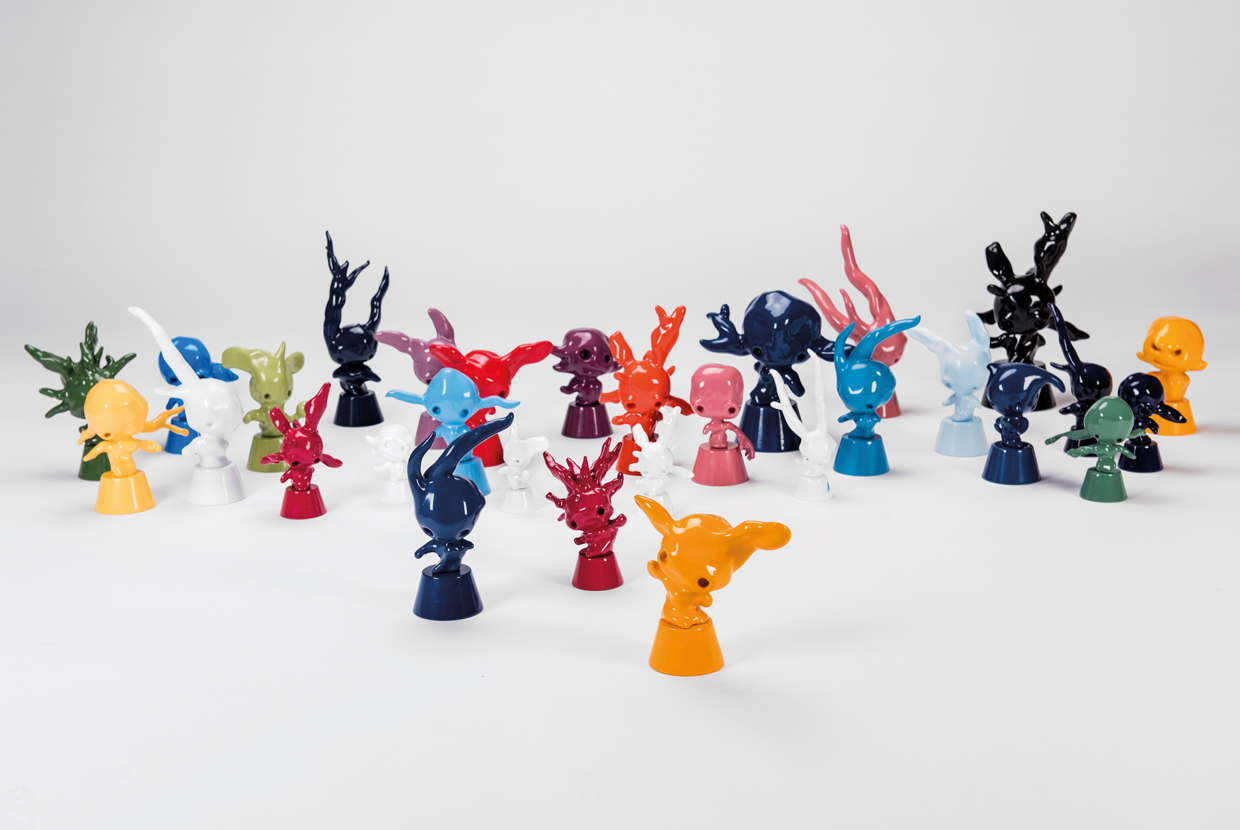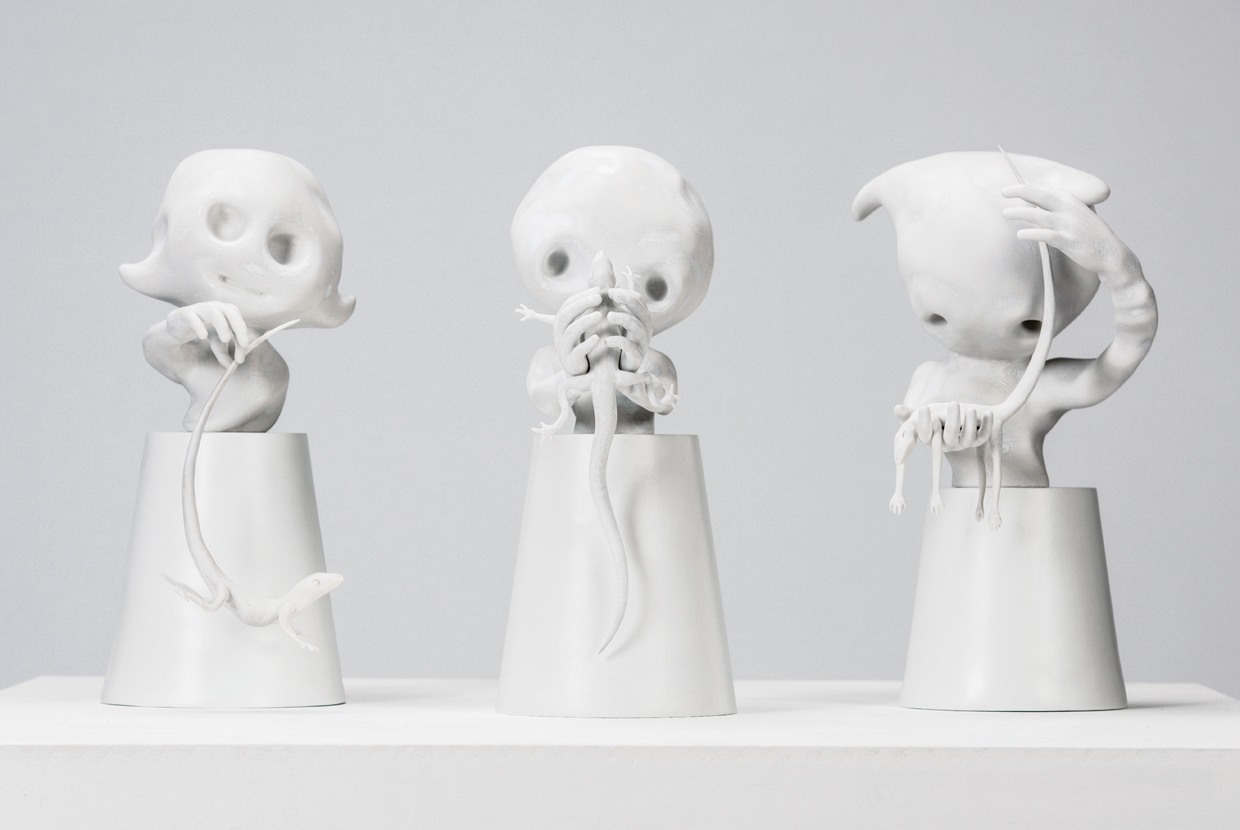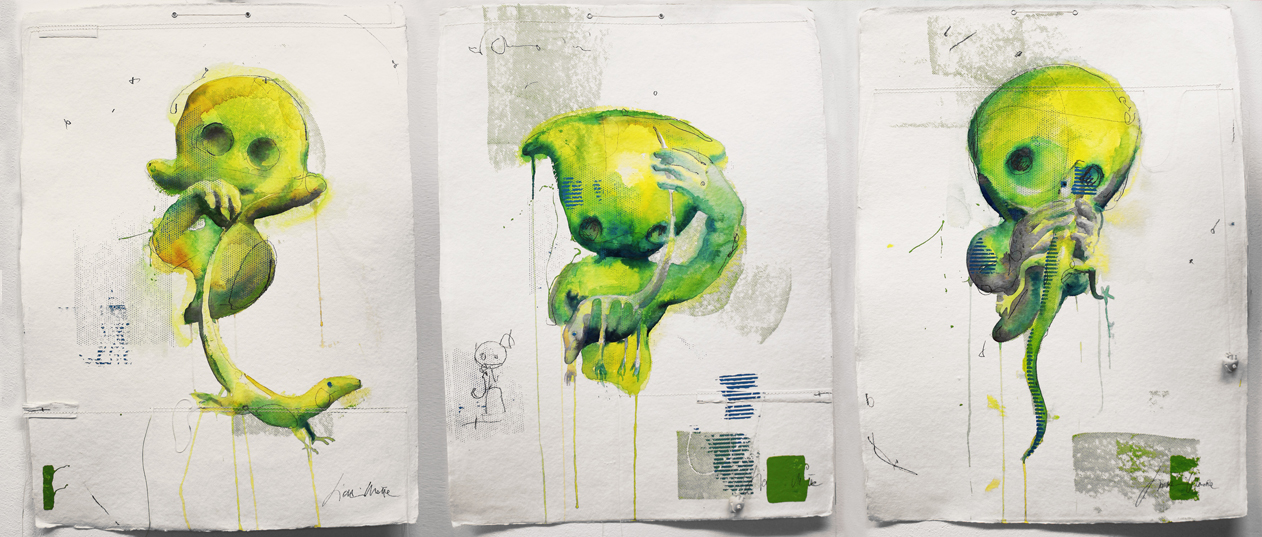I decided to concentrate on contents, on research, I did some tidying. I thought of something that my grandfather Alessandro used to say to me, always with a degree of sweetness: “Little Giovanni, concentrate on contents, nothing more and nothing less than what is necessary”. The work which makes up this exhibition can be considered the starting point of a deep pathway.
These works are born of memories linked to your childhood and of images, influenced by Japanese manga, which leads us to an important aspect of the work: the connection with the image, the iconography....
These works are the result of retrieving lost emotional states, linked to past events. Japan is a special place, where I have had unforgettable experiences. The Manga and Anime cultures have a value of memory, an experience which is linked to an emotion that can be retrieved.
Cartoons and comics, when linked to a precise historical moment and involving other elements such as a particular location or time of day, become a key for regaining access to a lost emotion, and enjoying it. They are a kind of time travel, in my case this is even more marked because I adored, worshipped them.
Your research sinks its roots in this fusion between existing images and personal memories, you could perhaps say it moves between public images and your own intimate perceptive conscience; it is a reflection on memory, on the emotion which accompanied a forgotten moment...
It is a reflection on memory, as soon as there is the chance to relive the lost emotional state linked to it. The public image is a key, like a smell, sound or colour could be. The lost memory is, in reality, an event, which occurred in a place, at a particular moment linked to an emotional state. A human being without memory is at the beginning of a path with no return. Memory is the essence of existence.
Ho deciso di concentrarmi sui contenuti, sulla ricerca, ho fatto pulizia. Ho pensato ad una frase che mi diceva, sempre con dolcezza, mio nonno Alessandro: “Giovannino, concentrati sui contenuti, niente di più e niente di meno di quello che è necessario”. Le opere che compongono questa mostra possono esser considerate l’inizio di un profondo percorso.
Queste opere nascono da ricordi legati alla tua infanzia e da immagini che sono suggestioni prese dai manga giapponesi, il che ci riconduce a un aspetto importante del lavoro: la relazione con l’immagine in quanto iconografia...
Queste opere nascono dal recupero di stati emozionali perduti collegati a fatti trascorsi. Il Giappone è un luogo speciale dove ho raccolto esperienze indimenticabili. La cultura Manga e Anime hanno un valore come ricordo, come esperienza legata ad un’emozione da recuperare. Un cartone animato o un fumetto se collocati in un preciso momento storico e affiancati ad altri elementi come un luogo o un orario della giornata, diventano la chiave per accedere al godimento di un’emozione scomparsa. Sono un mezzo di trasporto temporale, nel mio caso la cosa è accentuata perché li adoravo, li veneravo.
La tua ricerca affonda le radici in questa fusione tra immagini esistenti e ricordi personali, si può quasi sostenere che si muova tra un livello di immagini pubbliche e la tua intima coscienza percettiva, è una riflessione sulla memoria, sull’emozione del ricordo perduto...
È una riflessione sulla memoria nel momento in cui esiste la possibilità di riviverne lo stato emozionale perduto legato. L’immagine pubblica è una chiave come può esserlo un profumo o un suono o un colore. Il ricordo perduto è in realtà un fatto avvenuto in un luogo, in un momento preciso collegato ad uno stato emotivo. Un essere umano senza memoria è all’inizio di un cammino senza ritorno. La memoria è l’essenza dell’esistenza.

Tell us how a stratified resin sculpture, like “Blue Julian” and the Momonsters, created with 3D printing, is born.
The processes are the same, in the initial - or conception - phase, as well as in the design phases, and when the clay model is created. When making large sculptures like “Blue Julian”, I begin by modelling a block of high-density polystyrene. It is sculpted and polished until it takes shape.
At this point, layers of resin are applied by hand; they react with the polystyrene and penetrate internally, creating a very tough crust which is sanded and polished. Once the sanding is completed, the work is painted and polished further, until the finish is perfectly smooth.
With smaller sculptures, the modelled clay is scanned with a 3D scanner. The 3D file is then cleaned with a digital scalpel and then, when the digital sculpture is finished, it is printed in 3D. The piece produced is then sanded and finished by hand, before being painted. The 3D printer allows infinite copies of the same file to be produced. In my case, however, each work is a unique piece, each representing a unique and original memory.
How did you get the idea to use a 3D printer?
I was in the United States for work, and on a free day I went to visit a fair for new technology and saw one in action. I was struck by it. I immediately realised that I could create every one of my ideas, just having thought of it. It was like I was a child, and I had been given this tool as a gift, to make all my favourite toys. 3D printing technology is not just a tool for creating my work but is, in itself, part of the work.
“Blue Julian” could be considered a key to access your work, since it was the first of a series of monsters, continuing even today. How and when did you make it?
“Blue Julian” and “Red Atomic” are two monsters which opened the doors to this pathway. I remember it was summer, I had just arrived to see my family by the sea; it was a weekend at the end of June. I got close to the house’s walkway and walked the first few metres. I then quickly realised that on the plastic garden table there were two little sculptures, one red and one blue, around 6/7 cm in height. I then got closer. They were two little play dough sculptures, “Blue Julian” and “Red Atomic”. My two sons, Massimiliano and Ottaviano, had made them. I took them carefully in my hands, and I felt a feeling of fulfilment and connection with the universe, I felt as if they had given me truth, as if a kind hand was caressing my soul. I hugged my wife and my boys, and went straight back to Verona. A few hours after seeing them, I was already working, trying to understand how to make them.
Ci racconti come nasce una tua scultura in resina stratificata come “Blue Julian” e i “Momonsters” realizzate con la tecnologia della stampa in 3D?
Le procedure di realizzazione sono uguali nella loro parte iniziale ossia nella fase di ideazione, progettazione e creazione del modello in creta. Nel caso di sculture grandi come “Blue Julian” si procede con la modellazione di un blocco di polistirolo ad alta densità. Viene scolpito e levigato fino ad ottenere la forma. A questo punto inizia un procedimento di stesura a mano di diversi strati di resina che per una reazione con il polistirolo, penetrano al suo interno fino a creare una sorta di crosta durissima che viene carteggiata e levigata. Terminata la procedura di carteggiatura l’opera viene verniciata e levigata ulteriormente fino ad ottenere una finitura lucida e perfetta. Nel caso delle sculture più piccole, la creta modellata viene scannerizzata con uno scanner 3D, il file 3D che ne risulta viene pulito con uno scalpello digitale e poi, quando la scultura digitale è finita, si procede con la stampa tridimensionale. Il pezzo che viene prodotto è carteggiato e finito a mano per poi essere verniciato. La stampante 3D permette di ottenere copie infinite dello stesso file, ma nel mio caso, le opere sono pezzi unici perché ognuna, rappresenta un frammento di memoria unico e originale.
Come è nata l’idea di lavorare con una stampante 3D?
Mi trovavo negli Stati Uniti per lavoro, durante un giorno libero visitai una fiera sulle nuove tecnologie e la vidi in azione. Ne rimasi folgorato. Mi resi conto immediatamente che avrei potuto realizzare ogni mia idea solo per averla pensata. Era come se, da bambino, mi avessero regalato uno strumento per realizzare i miei giochi preferiti. La tecnologia di stampa 3D non è solo uno strumento di realizzazione dei miei pezzi ma è, a sua volta, parte dell’opera.
“Blue Julian” può essere considerato una chiave d’accesso al tuo lavoro, dal momento che è stato il primo mostro di una serie che continua ancora oggi. Come e quando l’hai realizzato?
“Blue Julian” e “Red Atomic” sono i due mostri che hanno aperto le porte di questo percorso.
Ricordo che era estate, avevo appena raggiunto la mia famiglia al mare, era un week end di fine giugno. Mi avvicinai al vialetto della casa al mare e ne percorsi i primi metri. Mi resi subito conto che sul tavolo di plastica del giardino c’erano due piccole sculture, una rossa ed una blu, circa 6/7 cm di altezza. Mi avvicinai ulteriormente. Erano due piccole sculture di pongo, “Blue Julian” e “Red Atomic”. Le avevano realizzate Massimiliano e Ottaviano, i miei due figli. Le presi in mano con delicatezza e provai una sensazione di pienezza e connessione con l’universo, mi sentivo come se mi avessero dato la verità, come se una mano dolce mi accarezzasse l’anima. Abbracciai mia moglie e i ragazzi e ripartii subito per Verona. Qualche ora dopo averli visti ero già al lavoro per capire come realizzarli.


In “Studio dell’ipotesi della nascita di un tiranno” (Study of the hypothesis on the birth of a tyrant) there are three creatures, each of which has a lizard in their hand. The first has caught it, the second is caressing it, and the third is holding the dead animal. It is a work in which it is easy to see oneself, I believe each of us has experienced something similar.
Everything revolves around experience, loss and the attempt to preserve that sensation....
I am curious about the dynamic of destiny, and its link with an emotional state, it is striking how randomness can be so precise. For you yes, for me no. Observing an event that has taken place, I link the situation with the event, and retrieve the emotion, isolate it and give it shape. The result freezes the experience and unleashes the emotion, allowing it to return and take shape.
Your paintings are also created with a complex painting technique, you can see a study of colour, of shape; the colours are very vivid, making the image anything but static. They are populated with amusing and fantastical monsters, which float at different levels of the work, moving as if pushed by mysterious internal forces. What is the genesis of these paintings?
The paintings represent invasions, by fragments of memories and the emotional states linked to them. The idea of this aesthetic comes from a movement one makes when they are tired, rubbing their eyes. The rubbing of the hands, on the closed eyelids, creates a dense mass of coloured speckles, moving all over, a universe of coloured shocks which dart around crazily. It is something that children often do.
The preparatory plans for the sculptures have a unique freshness and expressive strength: they are immediate and instinctive. You draw them and then colour them on sheets of Japanese paper (often sewn together), on which you hang little drafts portraying your “Momonsters”. These images have harmony, and this same harmony will not go to waste if the final design is a sculpture which has been enlarged in certain parts or indeed made smaller compared to the preparatory design. It is another dimension but the same logic...
The papers used for my drafts are made up of smaller parts because when I was young, I did not have large sizes available to me, so I got my mum to sew numerous sheets together. Thus it is like designing an emotion, the sheet loses its natural structure and becomes a work in and of itself. The process of creating these images gives my hands the awareness and safety for when I model the clay. These exercises prepare the hands for making the monster.
Which artists have influenced you the most? What do you feel when other artists give you stimulus?Hieronymus Bosch is the artist that has most influenced my fantasy. Takashi Murakami and Jeff Koons are an example of where I want to be. Egon Schiele has freshness of thought, linked to action, and Hayao Miyazaki is the master.
In “Studio dell’ipotesi della nascita di un tiranno” ci sono tre creature ed ognuna di loro ha in mano una lucertola. Il primo l’ha catturata, l’altro la accarezza e l’ultima la tiene in mano morta.
Un’opera in cui è facile ritrovarsi, credo che ognuno di noi da bambino abbia vissuto
un’esperienza simile.
Tutto ruota intorno all’esperienza, alla perdita e al tentativo di preservare quella sensazione…
Mi incuriosisce la dinamica del destino collegata allo stato emotivo, mi stupisce come la casualità sia così precisa. A te si, a me no. Osservando il fatto accaduto metto in relazione il caso con il fato e ne recupero l’emozione, la isolo e le assegno una forma. Il risultato congela l’esperienza e lascia libera l’emozione di tornare e prendere forma.
Anche i tuoi dipinti sono frutto di una complessa tecnica pittorica, si percepisce lo studio del colore, della forma, le tinte sono sgargianti, rendono l’immagine tutt’altro che statica. Sono popolate da mostri fantastici e divertenti che galleggiano sulla superficie in diverse profondità, si muovono come spinti da misteriose forze interne. Quale è la genesi di queste tele?
Le tele rappresentano invasioni di frammenti di ricordi e i collegati stati emotivi. L’idea di questa estetica nasce da un particolare gesto che si fa quando si è stanchi, stropicciarsi gli occhi. Lo sfregamento delle mani sulle palpebre chiuse genera un infinita massa di puntini colorati che si diffondono ovunque, un universo di scosse colorate che sfrecciano impazzite. È un’azione che da bambini capitava spesso di fare.
Gli studi preparatori per le sculture hanno una freschezza e una forza espressiva davvero unica: sono immediati e istintivi. Li disegni e poi colori su fogli di carta giapponese (spesso cuciti tra loro) su cui appendi anche dei piccoli bozzetti raffiguranti i tuoi “Momonster”. Sono immagini che hanno un’armonia, e questa stessa armonia non sarà dispersa se poi il progetto finale sarà una scultura ingrandita in alcuni punti o rimpicciolita rispetto al disegno preparatorio. È un’altra dimensione ma è la stessa logica…
Le carte dove realizzo i bozzetti sono fatte di più parti perché da piccolo, non avendo a disposizione grandi formati, mi facevo cucire assieme più fogli da mia mamma. In questo modo è come disegnare su un’emozione, il foglio perde la sua naturale struttura e diventa opera esso stesso. L’azione del realizzare queste immagini porta consapevolezza e sicurezza alle mie mani nel momento di modellazione della creta. Sono degli esercizi per preparare le mani alla realizzazione del mostro.
Quali artisti ti hanno suggestionato maggiormente? Come vivi gli stimoli che ricevi da altri autori?
Hieronymus Bosch è l’artista che più ha suggestionato la mia fantasia. Takashi Murakami e Jeff Koons sono un esempio di dove vorrei arrivare. Egon Schiele è la freschezza del pensiero collegato al gesto e Hayao Miyazaki è il maestro.